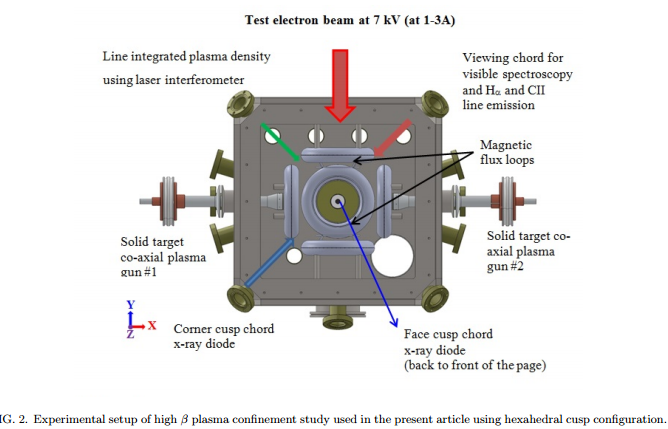EMC2 Fusion reports experimental results validating the concept that plasma confinement is enhanced in a magnetic cusp configuration when beta (plasma pressure/magnetic field pressure) is order of unity. This enhancement is required for a fusion power reactor based on cusp confinement to be feasible. The magnetic cusp configuration possesses a critical advantage: the plasma is stable to large scale perturbations. However, early work indicated that plasma loss rates in a reactor based on a cusp configuration were too large for net power production. Grad and others theorized that at high beta a sharp boundary would form between the plasma and the magnetic field, leading to substantially smaller loss rates. The current experiment validates this theoretical conjecture for the first time and represents critical progress toward the Polywell fusion concept which combines a high beta cusp configuration with an electrostatic fusion for a compact, economical, power-producing nuclear fusion reactor.
(H/T Talk Polywell)
The present experimental result is a major step toward a Polywell fusion reactor in that it validates the conjecture that high energy electron confinement is improved in a high β plasma. However, two additional measurements are needed to estimate the performance of a Polywell fusion reactor. The first is to quantitatively determine the loss rate. The second is to measure the efficiency of ion acceleration by electron beam injection.
In summary, the present experimental results demonstrate for the first time that high β plasma operation can dramatically improve high energy electron confinement in the magnetic cusp system. This result validates the central premise of the Polywell fusion concept which uses high energy beam injected electrons to create an electrostatic potential well for ion acceleration and confinement. The current plan is to extend the present work with increased electron beam power to sustain the high β plasma state and to form an electrostatic well. If the deep potential well can be formed and the scaling of the electron beam confinement is found to be favorable, as conjectured by Grad and others, it may be possible to construct a compact, low cost, high β fusion power reactor based on the Polywell concept.
For the purpose of discussion, they estimate the power balance for a 1 meter radius hexahedral D-T Polywell fusion reactor operating at β=1 with a magnetic field of 7 Tesla at the cusp points and an electron beam injection energy at 60 kV.
This calculation is based on two assumptions:
1) the electron loss rate in Equation 1 is correct, and
2) the efficiency of ion acceleration via a potential well can be made good enough to convert 50% of electron beam injection energy into an average ion energy.
From Equation 1, the electron loss current is 254 A per cusp for the electron density 2 × 10^15 cm−3 and electron energy at 60 keV at the cusp points. Since there are 14 cusps in the hexahedral system, the required electron beam power to maintain a β=1 state would be 213 MW. Separately, this system will lose an additional 51 MW of power via Bremsstrahlung radiation for an average elec- tron temperature of 60 keV, assuming no ions other than hydrogen isotopes are present.
In comparison, the expected D-T fusion power output would be 1.9 GW for a D-T cross section of 1.38 barns at a center of mass energy of 30 keV.
The magnetic cusp experiments described in this paper were conducted in a cubic vacuum chamber measuring 45 cm on an edge. Centred in this chamber are six identical magnet coils, each coil having major radius 6.9 cm and minor radius 1.3 cm. The coils are arranged such that each coil is centered on a face of a cube measuring 21.6 cm on an edge producing cusp magnetic field. Each coil is driven by its own battery powered system capable of generating a static magnetic field from 0.6 kG to 2.7 kG at the cusp near the coil center with coil currents between 5-22 kA turns. The coils are energized for pulse duration of 40 ms compared to the 100 (microsecond) plasma duration, thus generating static magnetic field during the time of interest.
If you liked this article, please give it a quick review on ycombinator or StumbleUpon. Thanks

Brian Wang is a Futurist Thought Leader and a popular Science blogger with 1 million readers per month. His blog Nextbigfuture.com is ranked #1 Science News Blog. It covers many disruptive technology and trends including Space, Robotics, Artificial Intelligence, Medicine, Anti-aging Biotechnology, and Nanotechnology.
Known for identifying cutting edge technologies, he is currently a Co-Founder of a startup and fundraiser for high potential early-stage companies. He is the Head of Research for Allocations for deep technology investments and an Angel Investor at Space Angels.
A frequent speaker at corporations, he has been a TEDx speaker, a Singularity University speaker and guest at numerous interviews for radio and podcasts. He is open to public speaking and advising engagements.




